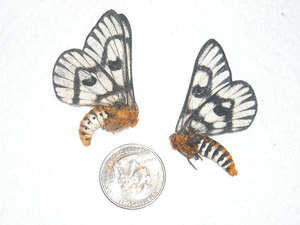Brust co-authors journal article about sagebrush buck moth

CHADRON – Chadron State College Professor of Science Dr. Mathew Brust has co-authored an article about the sagebrush buck moth in the Journal of the Lepidopterists’ Society with Dr. Gerald M. Fauske, manager of the North Dakota State Insect Reference Collection at North Dakota State University.
The only sagebrush buck moth specimens ever verifiably collected in Nebraska are in the CSC collection because Brust is the only person to have collected them.
In the article, Brust discusses the ways High Plains insects adapt to extreme weather conditions, evade predators, and find food supplies.
One method of survival this large, colorful buck moth uses is feeding on big sagebrush during the caterpillar stage, the longest phase of its life. It cannot eat or drink during the short adult, flying phase. Brust said remaining green year-round makes big sagebrush an important keystone plant species in western Nebraska, providing forage for insects and mammals, such as pronghorn, compared to several other types of seasonal sagebrush.
“Most maps, inaccurately, don't show big sagebrush growing widely in the Plains states, so it has been incorrectly assumed that the buck moth doesn’t live here either,” Brust said.
Brust noticed an entry for the sagebrush buck moth with two or three dots in western North Dakota on a website curated by Fauske.
“About 20 years ago a Forest Service employee in the Black Hills photographed a caterpillar on big sagebrush and we identified it as a sagebrush buck moth making the caterpillar the new state record for South Dakota,” Brust said.
Brust conjectured that if North Dakota and western South Dakota had the buck moth, then the northern Nebraska Panhandle probably did too. He was right.
“It was the very end of August and I’m driving south on Highway 71 and just cross into Dawes County near a Badlands area. I think I’m hallucinating because one of them flies over the windshield. I park and get out. It took me a good half hour because they are fast flyers, but I managed to catch two males,” Brust said.
After documenting these two Nebraska state records of sagebrush buck moth, Brust kept looking for them. In subsequent years he has collected the species at a site in Sioux County, as well.
In the article, Brust also explores hatching times as a possibility factor that keeps temporal populations of the species separate.
“One of the things about the high mountain environments is summers are short, and so they actually require two years of development to reach adulthood in those areas. Those that mature in a single year fly about two to three weeks later than the ones that mature in two years. If populations aren't flying at the same time, even though they live in the same area, they might not blend much,” Brust said.
—Tena L. Cook, Marketing Coordinator
Category: Campus News



